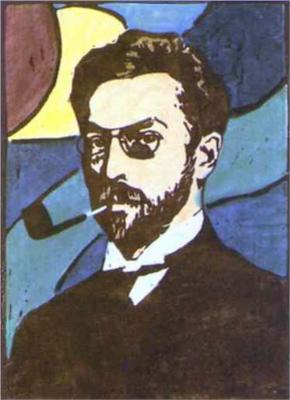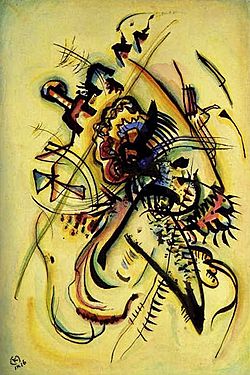Part One
Art History Lesson: Kandinsky

Wassily Kandinsky Background...
- Born in 1866 in Moscow, Russia, and died in 1944 in France.
- He began his journey in painting as a thirty year man.
- Studied at the Academy of Fine Arts in Munich, Germany.
- Taught at the word famous Bauhaus School of Art and Architecture from 1922 to 1933, until the Nazis closed the school.
Beginnings in Art and Influences...
- When Kandinsky was a young boy, he noticed his attraction to color. Later in his life, this love of color turned into a study of color theory and the psychology behind it.
- In Moscow, he would visit churches and homes in the area, and was taken with the use of bright colors used for the decorations. He stated how it made him feel as though he was inside a painting, which some of his early work (example below) was influenced by.
- Some of the main influences throughout his career were geometric designs, mainly incorporating shapes and lines throughout.

To the Unknown Voice, 1916
Him as an artist...
- Widely known as the "father of abstraction".
- Very inspired by other central figures in art history such as Monet, Matisse and the Fauves art movement.
- His main painting technique was simplifying the places around him in the places, early in his career (an example like the one below).
- In Munich, he was a member of the group called Der Blaue Reite, which translates to "The Blue Rider". They experimented with many different ways of painting, and often surprised many critics with their artistic choices.
- He believed that his love of music was intertwined with his love of painting, that the loves promoted each other. He even named many of his works after musical vocabulary, such as Composition.
Bayerisches Dorf mit Feld, 1908
- He used color in a way that was unlike many artists. It was not painting in a section with a color, but rather it seemed that the color was not restrained by an outer line. He wanted to challenge his viewers to think in a new way. "According to Professor Rose-Carol Washton Long, an authority on Kandinsky, this meant the spectator ‘taking part in the creation of the work almost as if taking part in a mystic ritual… Kandinsky forces [us] to decipher mysterious images’.
- During his time teaching at the Bauhaus (for example, the one below), his technique changed to a more geometric style. During his time there, he taught painting of murals and an introduction to analytical drawing.
.jpg?w=780)
Oben und links, painted in Weimar, March 1925
- At the end of his life and career, his technique and aesthetic change for the last time. The colors became softer, the shapes more organic, and he also used a scientific look in his works.
- During this time of his life, he created the most paintings than he did in any other time of his life.
.jpg?w=780)
Rigide et courbé, executed in Paris, December 1935
Assignment...
After the lesson, please answer these questions. A sheet will be sent home with the students, and will be due at the beginning of class the following day of school.
1. When was Kandinsky born? And where was he born?
2. Do you think this impacted his artwork and his subjects used in his early works?
3. What age did he begin his career?
4. How do you think that beginning his career later in life dictated his artwork and his creative choices?
5. Kandinsky was known as one of the ______________ of ______________.
6. The group that Kandinsky joined was named _______ __________ ___________, which translates into The ________ _________.
7. How do you think that being apart a group of like-minded artists, that pushed the boundaries of what art was like during this era, helped Kandinsky in his artistic journey?
8. How do you think music impacted Kandinsky’s artistic choices? What connection do you see between music and painting, or how do you think they are not connected?
9. During what period did Kandinsky make the most work?
10. Why do you think that it was during this time that Kandinsky created most of his work?
11. Lastly, how do you think Kandinsky impacted the history of art in your own words?
.jpg?w=780)
Comments
Post a Comment